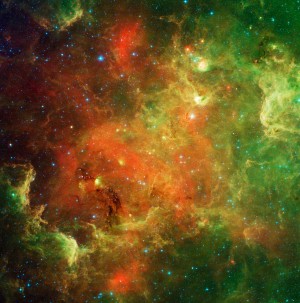‘Earth & Sky’ Archives
April 30, Watch for Venus and moon east before sunrise

Courtesy of EarthSky A Clear Voice for Science Visit EarthSky at www.EarthSky.org Given an unobstructed eastern horizon and clear skies, many people around the world should be able to see the waning crescent moon with the planet Venus at morning dawn tomorrow (Sunday, May 1). At mid-northern latitudes – like those in the continental US – the moon and Venus sit close to the eastern horizon around 60 to 45 minutes before sunup. Understanding waning crescent moon The farther north you live, ... Full Story
Sky Tonight—April 29, Five planets before sunrise

Courtesy of EarthSky A Clear Voice for Science Visit EarthSky at www.EarthSky.org Only Venus easily visible We show the moon and planets for about 30 minutes before sunrise tomorrow (Saturday, April 30) as seen from North American mid-northern latitudes. At mid-northern latitudes all around the world, the only two worlds that you are likely to see before sunrise tomorrow are the moon and blazing planet Venus. Look for them low in the east some 60 to 30 minutes before sunup. Binoculars might ... Full Story
Sky Tonight—April 27, Leo loses his tail. We gain a

Courtesy of EarthSky A Clear Voice for Science Visit EarthSky at www.EarthSky.org Tonight’s chart again shows the evening sky high to the south. To the upper left of the constellation Leo the Lion are dozens of very faint stars. They make up the constellation Coma Berenices, otherwise known as Berenice’s Hair. The Greek-Egyptian astronomer Ptolemy and others considered it the tuft at the end of Leo the Lion’s tail. Coma Berenices remained part of Leo until a few hundred years ago, when it ... Full Story
Sky Tonight—April 26, Star-hop from Leo to the Coma

Courtesy of EarthSky A Clear Voice for Science Visit EarthSky at www.EarthSky.org Our diagram shows the constellation Leo the Lion for about 9 p.m. to 10 p.m. tonight. At this time, the Lion will be due south and at his highest point in the sky. Two distinctive star patterns make the Lion easy to identify. Leo’s brightest star – the sparkling blue-white gem Regulus – dots a backward question mark of stars known as The Sickle. If you see a Lion in this pattern of stars, the Sickle outlines ... Full Story
Sky Tonight—April 25, Orion descends in the west

Courtesy of EarthSky A Clear Voice for Science Visit EarthSky at www.EarthSky.org The famous constellation Orion will soon disappear for another season. At this time of year, Orion is descending in the southwest to west in the hours after sunset. This constellation is noticeable for its bright stars and its distinctive pattern on the sky’s dome. Look for three stars in a short, straight row. Also look for Betelgeuse and Rigel, Orion’s brightest stars. If you did not come to know it this ... Full Story
Sky Tonight—April 24, Kochab and Pherkad in the

Courtesy of EarthSky A Clear Voice for Science Visit EarthSky at www.EarthSky.org If you draw an imaginary line between the two outer stars in the bowl of the Big Dipper – and extend that line northward on the sky’s dome – you’ll come to Polaris, the North Star. Polaris marks the end of the handle of the Little Dipper, which is fainter and looks less like a dipper than the Big Dipper. Polaris is special because Earth’s axis nearly points to its location in the sky. Polaris is less ... Full Story
Sky Tonight—April 23, Two stars lead to

Courtesy of EarthSky A Clear Voice for Science Visit EarthSky at www.EarthSky.org The constellation Hercules the Kneeling Giant can be seen ascending in the east-northeast on these spring evenings. Our chart today shows the sky for late night, when all of these objects are well up in the northeastern to eastern sky. The stars Arcturus and Vega can help you identify Hercules, whose most noticeable pattern is a squarish figure in the center of the constellation. This sky pattern, or ... Full Story
Sky Tonight—April, 22, Peak of Lyrid meteor shower

Courtesy of EarthSky A Clear Voice for Science Visit EarthSky at www.EarthSky.org Tonight presents the expected peak of the Lyrid meteor shower, from late night Friday (April 22) until dawn Saturday (April 23). Usually, the hour before dawn is best, except that a bright waning gibbous moon will be lighting the sky. This year, some people may choose to watch late at night, during the dark hour before moonrise. Moonrise time for your sky Our chart shows the constellation Lyra again – a closer ... Full Story
Sky Tonight—April 21, Lyrid meteors fly in

Courtesy of EarthSky A Clear Voice for Science Visit EarthSky at www.EarthSky.org Photo credit from Computer Science Geek’s photostream The 2011 Lyrid meteor shower will pepper the night tonight between late night and dawn (April 21/22). However, the more likely peak night will be tomorrow (April 22/23), from late night Friday until dawn Saturday. However, you may see nearly the same number of meteors tonight. However, these meteors will be flying in the light of a bright ... Full Story
Sky Tonight—April 20, Vega marks radiant point of

Courtesy of EarthSky A Clear Voice for Science Visit EarthSky at www.EarthSky.org The 2011 Lyrid meteor shower is now picking up steam in the light of the waning gibbous moon. We hear from people all the time who see marvelous meteors in the light of the moon. Still, a dark sky is best for meteor showers, and the moon will drown all but the brightest Lyrid meteors from view this year. Understanding moon phases This shower is expected to produce the most meteors before dawn on April 22 ... Full Story








